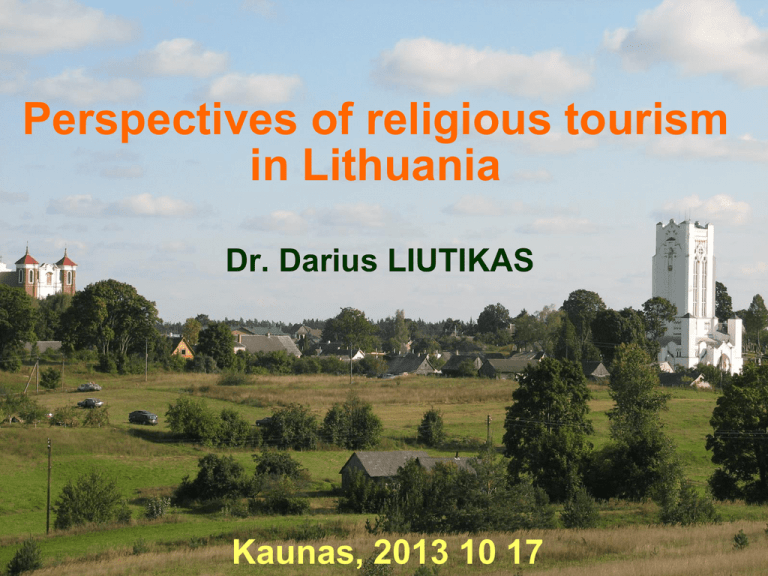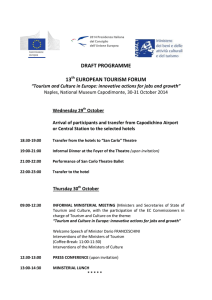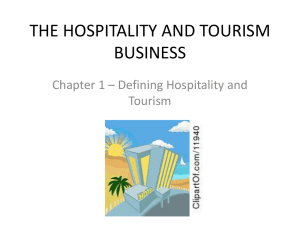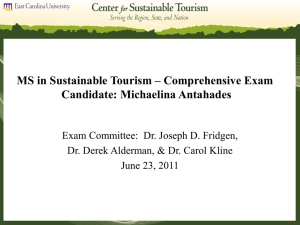
Perspectives of religious tourism
in Lithuania
Dr. Darius LIUTIKAS
Kaunas, 2013 10 17
What is religious tourism?
Pilgrimage
Religious
tourism
Tourism
or
•Cultural tourism
•Heritage tourism
•Religious tourism
•…………….
Tourism
Relationship between religious
tourism and pilgrimage
Religious tourism as that type of tourism when participants are
motivated either in part or exclusively for religious reasons.
We can distinguish three ways in relationship between pure
pilgrimage and religious tourism.
1)
pilgrimage is the same phenomenon as religious tourism (here
the terms are used interchangeably, the conception of these
phenomena is the same);
2)
pilgrimage is considered to be a special form or specific part of
religious tourism;
3)
pilgrimage differs from religious tourism, which is considered to
be an intermediate form between religious pilgrimage and
secular tourism.
Conception of valuistic journeys
Valuistic journeys = traditional religious and
modern secular pilgrimage
Such journeys seek to express attitudes to
values and outline the guidelines for the
identity of their participants
Conception of valuistic journey
(pilgrimage)
Important features of the valuistic journey:
clearly expressed geographical destination of the
journey, which embodies a certain value;
valuistic motives of the journey, internal attitudes
impelling to carry out the journey;
strongly expressed link between the journey and the
identity of the traveller where the journey is an
expression of personal identity or search for this
identity;
specific behaviour during the journey and at the
destination point characterised by typical rites or
models of behaviour.
Classification of journeys
Journeys
Recreational and
cognitive
journeys
Valuistic
journeys
(religious
pilgrimage,
journeys of sport
fans etc.)
Necessity and
instrumental
journeys (business
trips, travelling for
medical treatment,
visiting of friends
and family,
conferences etc.)
Types of valuistic journeys
Types of recreational and cognitive
journeys
1.
Adventure tourism
2.
Resort tourism
3.
Cultural and heritage tourism
4.
Rural tourism
5.
Ecotourism
6.
Mountain tourism
7.
Sex tourism
8.
Shopping tourism
9.
Sport tourism
10. Religious tourism
11. Political tourism
Main geographical objectives of
pilgrimage and religious tourism
Sacred places:
-Associated with the origin of religion and centers of religion;
-Associated with the birth, life or death of the founders of religion,
prophets or holy men;
-Apparition places;
-Graves of saints or prophets;
-Relics, images and other miraculous cultural or natural objects;
-Essential religious places (cult objects, specific objects, example
Calvaries in Christianity);
-Monasteries and living saints;
-Important events of religious life (meeting the religious leader, the
renewal days etc.).
Origin of Lithuanian Christian Pilgrimage
The origins of Christian pilgrimage in Lithuania date back to
the XVI century. The main reason for this was the late
christening of Lithuania and the slow establishment of
Christianity.
The first organized pilgrimage journey was held by Jesuits
from Vilnius to the miraculous image of the Mother of God and
Child in Trakai in 1604.
After 1608, Blessed Virgin apparition pilgrims started to flow
to Šiluva. A new Catholic church was built there in 1627.
The Samogitian Calvary was created between 1637 and
1642 by the initiative of Samogitian Bishop Jurgis Tiškevičius.
Vilnius (Verkių) Calvary was created between 1662 and 1669.
History of Lithuanian Pilgrimage
In the middle of the XIX century a unique sacred place was
formed – the Hill of Crosses.
The
XX century additionally marked the Lithuanian
pilgrimage map with apparition places of the Blessed Virgin
Mary. Such places as Gulbinėnai, Imbradas, Keturnaujiena,
Skiemonys are not officially recognized by the Catholic
Church but are very popular as pilgrimage destinations of folk
religiosity.
During the soviet occupation various obstructions were
implemented to prevent people from visiting sacred places,
and a campaign of physical destruction of sacred places was
embodied.
Classification types of Lithuanian
Pilgrimage Places
Origin
Natural places (springs);
Cultural places (Churches);
Object of adoration
Virgin Mary,
Christ,
Saints,
Spiritual authority;
Circumstances of origin
Natural-historical (cemeteries, tombs)
Miraculous (apparition places, miraculous images and
relics).
Catholic pilgrimage places in Lithuania
Pilgrim Route of John Paul II in Lithuania
Established in August 2007
16 main Catholic pilgrimage places of Lithuania
including the Hill of Crosses were joined:
1.
Vilnius Cathedral Basilica. Chapel of St Casimir
2.
Gate of Dawn Chapel and St Teresa’s Church (Vilnius)
3.
Vilnius Calvary
4.
Trakai Church of the Visitation
5.
Kaunas Cathedral Basilica
6.
Christ’s Resurrection Church in Kaunas
7.
Pažaislis Church and Monastery
8.
Shrine of Šiluva
9.
Tytuvėnai Church and Monastery
10.
Šiauliai Cathedral
11.
Hill of Crosses
12.
Samogitian Calvary Shrine
13.
Marijampolė Basilica and Chapel in Lūginė
14.
Pivašiūnai Church of the Assumption
15.
Divine Mercy Shrine in Vilnius
16.
Krekenava Shrine
Places of the Pilgrim Route of Pope John Paul II
Possible Routes. St. Jacobs
Churches
1) Punia
2) Alanta
3) Jonava
4) Kurtuvėnai
5) Žiežmariai
6) Švėkšna
7) Vilnius (Church of Sts. Jacob and Philip)
8) Joniškis (Molėtai region)
9) Suvainiškis (Rokiškis region)
10) Onuškis (Church of Sts. Jacob and Philip)
11) Rudiškės (Jonava district, Church of Sts. Jacob and
Philip)
Needs of pilgrims
-basic needs (food, drinking water, accommodation,
toilets, etc.);
-cultural (following the rituals and traditions, cognitive
development, recreation, aesthetical satisfaction);
-social (social security, communication with relatives,
friends, neighbours);
-spiritual (spiritual renewal, expressing gratitude to Jesus,
asking for God’s grace, penance, etc.).
Needs of religious tourists
-basic needs (food, drinking water, accommodation,
toilets, etc.);
- commodities (goods, souvenirs, local food and drinks,
attractive shows, new experience);
-cognitive (cognitive development, recreation, aesthetical
satisfaction);
-social (social security, communication with co-travelers);
-spiritual (spiritual renewal etc.).
Accessibility and duration of pilgrimage
Well accessible pilgrimage places
- the accessibility of Lithuanian pilgrimage places during the indulgence
feast is mainly by car or coach. Local people reach the the place on foot or local
transport in cities.
Lacks
- lack of infrastructure for parking places (cars are parked at the roadsides
nearby villages), of accommodation (pilgrims can stay over the night mainly in
private houses), of inside catering service (mainly you can eat at outside cafes
and other places).
Duration of pilgrimage. Samogitian Calvary
- is usually one-day trip without staying overnight (need from 2 till 4 hours
to overcome the Way of Cross, one additional hour is devoted for Holy Mass,
and up to one or two hours pilgrims could spend in the market or in
communication with friends, relatives or acquaintances.
Perspectives of religious tourism in
Lithuania
Strengths
1. A fair amount of religious tourism and religious heritage places;
2. Some exceptional pilgrimage sites (The Hill of Crosses)
3. Attractive surroundings of pilgrimage places in the cities (other
architectural and historical heritage) or in the villages (scenic landscapes);
4. Route possibilities (walking routes in countryside).
5. Visiting traditions (indulgence feasts, traditions to go on foot to some
sacred places).
Limitations
1. Political – unclear or very broad goals of Lithuanian tourism policy;
2. Country attraction – fragmentized image of Lithuania as tourism country;
3. Promotion of religious tourism places is very marginal.
4. Lack of infrastructure, entertainment and accommodation facilities at the
religious tourism places
In Lithuanian
Liutikas, D. (2009)
Piligrimystė. Vertybių ir
tapatumo išraiškos
kelionėse, Vilnius:
Lietuvos piligrimų bendrija.
In English
Liutikas,
D.
(2012)
Experiences of Valuistic
Journeys: Motivation and
Behaviour. In: Sharpley,
R., Stone, Ph. (eds),
Contemporary
Tourist
Experience: Concepts and
Consequences, (pp. 3856). New York: Routledge.
Literature
Thank you for your attention










